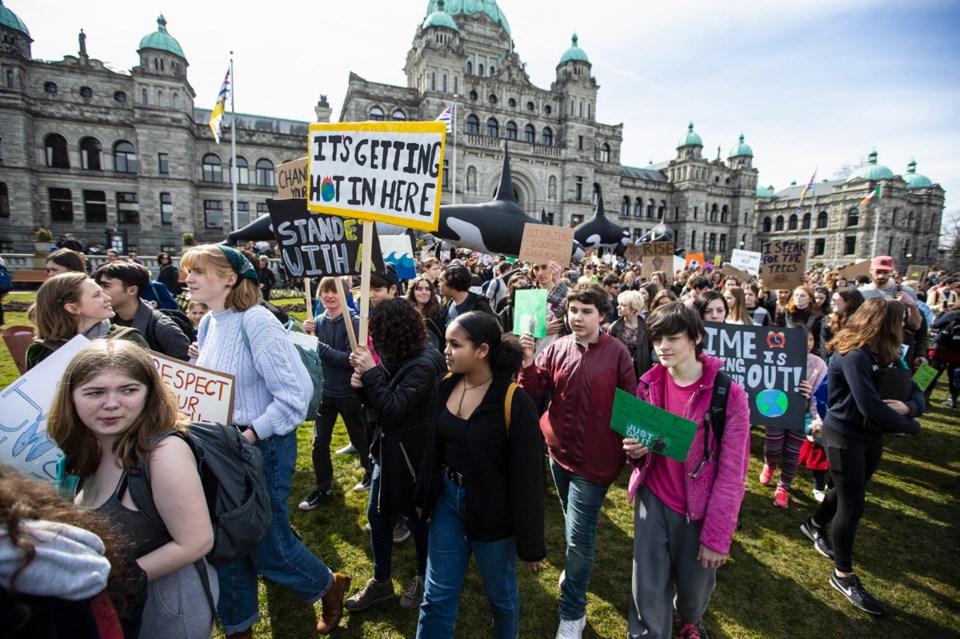Hundreds of Greater Victoria students marched out of classes Friday to take part in an international school walkout calling on leaders to take tougher action on climate change.
From the South Pacific to the edge of the Arctic Circle, angry students in more than 100 countries walked out of classes to protest what they see as failures by their governments. More than 55 events were planned in cities and towns across Canada.
Students from around Greater Victoria gathered at the legislature at noon.
“We are the first generation to experience the impacts of climate change and the last generation who will be able to do anything about it,” said Finn Kresischer, 14, a member of the City of Victoria Youth Council.
The Victoria event was sponsored by Rise and Resist, Social Environmental Alliance, Youthforclimate.ca and Extinction Rebellion Vancouver Island.
The protesters directed demands at the Canadian and B.C. governments to halt all new fossil fuel projects, including the Trans Mountain pipeline expansion and Canada LNG project, and stop logging of ancient temperate rainforests on Vancouver Island.
An estimated 2,000 people gathered for a similar rally and march in Vancouver. In Montreal, a march spanned several city blocks as thousands of students and other protesters denounced what they see as government’s failure to take action to stop an impending climate crisis.
Environment Minister Catherine McKenna praised the young Canadians participating in the marches and encouraged them to continue taking action for a more sustainable future.
“They know climate change is real, and that the cost of inaction is enormous,” she said in a statement.
The co-ordinated “school strikes” were inspired by 16-year-old Swedish activist Greta Thunberg, who began holding solitary demonstrations outside the Swedish parliament last year.
Since then, the weekly protests have snowballed from a handful of cities to hundreds, fueled by predictions about the impact of climate change during the students’ lifetime.
Unless emissions of heat-trapping gases start dropping dramatically, scientists estimate that the protesters will be in their 40s and 50s, maybe even 30s, when the world will reach dangerous levels of warming that international agreements are trying to prevent.
Thunberg, who has been nominated for the Nobel Peace Prize, said at a rally in Stockholm that the world faces an “existential crisis, the biggest crisis humanity ever has faced and still it has been ignored for decades.”
In B.C., the movement received support from B.C. Green Party Leader Andrew Weaver, who said his caucus was inspired by the students.
“Our children are telling us that it is time to treat this crisis as a crisis, and they are right,” Weaver said in a statement. “I am humbled and honoured to stand with the world’s children and youth as they demand political action on climate change.
“All of the science is pointing to the fact that we are fast running out of time to avoid global catastrophe, and yet around the world political leaders are failing to consider the existential threat that we face. To quote Greta Thunberg, we need to focus on what needs to be done rather than what is politically possible.”
B.C. Environment Minister George Heyman said he was inspired by the concern and commitment of the students.
“All the evidence speaks to the need to act today, and we all have a responsibility to rise to the challenge,” he said.
“Here in B.C. we’ve seen unprecedented wildfires and floods that hurt people, communities and businesses.”
He said B.C.’s climate plan focuses on clean, renewable energy while reducing carbon pollution.
“What the student climate leaders who came to my office told me was: ‘The time for talk has passed. It’s time to take action.’ I couldn’t agree more. And taking these actions will make life better today, as well as tomorrow.”
A world of protest
Across the globe, protesters urged politicians to act against climate change while highlighting local environmental problems:
• In India’s capital of New Delhi, schoolchildren protested inaction on climate change and demanded that authorities tackle rising air pollution levels, which often far exceed World Health Organization limits.
• In Paris, teenagers thronged streets around the domed Pantheon building. Some criticized French President Emmanuel Macron, who sees himself as the guarantor of the landmark 2015 Paris climate accord but is criticized by activists as too business-friendly and not doing enough to reduce emissions.
• In Washington, protesters spoke in front of a banner saying “We don’t want to die.”
• In San Francisco, 1,000 demonstrators descended on the local offices of Sen. Dianne Feinstein and House Speaker Nancy Pelosi, wanting passage of the massive “Green New Deal” bill proposed in the U.S. Congress.
• In St. Paul, Minnesota, about 1,000 students gathered at the state capitol, chanting “Stop denying the Earth is dying.”
• In South Africa’s capital, Pretoria, one protester held a sign reading “You’ll Miss The Rains Down in Africa.” Experts say Africa, with more than one billion people, is expected to be hardest hit by global warming even though it contributes least to greenhouse gas emissions.
• Hundreds of students took to the streets of downtown Los Angeles chanting “What do we want? Science! When do we want it? After peer review.”
• Thousands marched in rainy Warsaw and other Polish cities to demand a ban on burning coal, a major source of carbon dioxide. Some carried banners that read “Make Love, Not CO2.”
• Protests in Madrid and more than 50 other Spanish cities drew thousands. The country is vulnerable to rising sea levels and rapid desertification.
— With files from Vancouver Sun, Canadian Press and Associated Press



